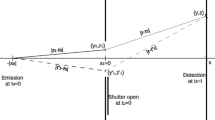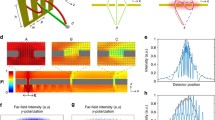Abstract
The double slit problem is idealized by simplifying each slit by a point source. A composite reduced action for the two correlated point sources is developed. Contours of the reduced action, trajectories and loci of transit times are developed in the region near the two point sources. The trajectory through any point in Euclidean 3-space also passes simultaneously through both point sources.
Similar content being viewed by others
References
Floyd, E.R.: Phys. Rev. D 34, 3246 (1986)
Floyd, E.R.: Gravitation and cosmology: from the Hubble radius to the Planck scale. In: Amoroso, R.L., Hunter, G., Kafatos, M., Vigier, J.-P. (eds.) Proceedings of a Symposium in Honour of the 80th Birthday of Jean-Pierre Vigier. Kluwer Academic, Dordrecht (2002), extended version promulgated as quant-ph/00009070
Floyd, E.R.: Interference, reduced action and trajectories. Found. Phys. 37 (2007, in press)
Faraggi, A.E., Matone, M.: Int. J. Mod. Phys. A 15, 1869 (2000), hep-th/98090127
Bertoldi, G., Faraggi, A.E., Matone, M.: Class. Quantum Gravity 17, 3965 (2000), hep-th/9909201
Carroll, R.: Can. J. Phys. 77, 319 (1999), quant-ph/9904081
Carroll, R.: Quantum Theory, Deformation and Integrability, pp. 50–56. Elsevier, Amsterdam (2000)
Carroll, R.: Uncertainty, trajectories, and duality. quant-ph/0309023
Morse, P.M., Feshbach, H.: Methods of Theoretical Physics, Part II, p. 1284. McGraw–Hill, New York (1953)
Philippidis, C., Dewdney, C., Hiley, B.J.: Nuovo Cimento B 52, 15 (1979)
Guantes, R., Sanz, A.S., Margalef-Roig, J., Miret-Artés, S.: Surf. Sci. Rep. 53, 199 (2004)
Bohm, D.: Phys. Rev. 85, 166 (1953)
Floyd, E.R.: Phys. Rev. D 26, 1339 (1982)
Goldstein, H.: Classical Mechanics, 2nd edn., p. 441. Addison–Wesley, Reading (1980)
Morse, P.M., Feshbach, H.: Methods of Theoretical Physics, Part I, p. 661. McGraw–Hill, New York (1953)
Holland, P.R.: The Quantum Theory of Motion, pp. 85–86, 183, 201. Cambridge University Press, Cambridge (1993)
Zhao, Y., Makri, N.: J. Chem. Phys. 119, 60 (2003)
Author information
Authors and Affiliations
Corresponding author
Additional information
Communicated by vd Merwe.
Rights and permissions
About this article
Cite this article
Floyd, E.R. Welcher Weg? A Trajectory Representation of a Quantum Young’s Diffraction Experiment. Found Phys 37, 1403–1420 (2007). https://doi.org/10.1007/s10701-007-9155-3
Received:
Accepted:
Published:
Issue Date:
DOI: https://doi.org/10.1007/s10701-007-9155-3




